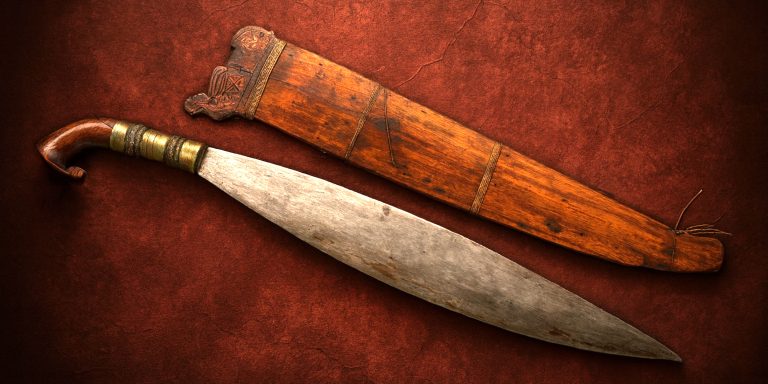
The paramerion was a distinctive curved sword used during the later centuries of the Byzantine Empire, particularly by cavalry units. It reflects both the eastern influences absorbed by the Byzantines and their evolving military needs during constant conflicts with steppe nomads, Arabs, and Turks. The word “paramerion” itself comes from the Greek παραμήριον, meaning “by the thigh”, referencing how the weapon was typically worn.
More than just a sidearm, the paramerion represents a turning point in Byzantine martial culture. Unlike the straight spathion or the earlier Roman gladius, this sword embraced curvature for slashing efficiency, likely influenced by Middle Eastern and Central Asian sabres.
Specifications
| Feature | Description |
|---|---|
| Type | Curved sabre-like cavalry sword |
| Length | Approx. 75–90 cm (blade) |
| Blade | Single-edged, curved, tapering to a point |
| Hilt | Straight crossguard, often minimalistic |
| Grip | One-handed, occasionally with a ring pommel |
| Sheath | Suspended from a baldric (shoulder strap) |
| Materials | Iron or steel blade, wooden or bone grip |
| Use | Primarily cavalry, later adopted by infantry |
History and Evolution
The paramerion began to appear prominently in Byzantine military art and documents from the 10th to the 14th centuries. Its development corresponds with a broader military shift influenced by interactions with Turkic and Arab forces who favoured curved sabres for horseback fighting.
- 10th–11th centuries: Early examples emerge during wars in Asia Minor. The curved shape begins replacing the spathion for mounted troops.
- 12th–13th centuries: Widespread use across Byzantine cavalry, visible in manuscripts like the Madrid Skylitzes.
- 14th century: Becomes common in the Palaiologan military era, often adapted with Turkish-style fittings.
- Post-Byzantine: Its design influences later Balkan and Eastern European sabres.
The paramerion did not completely replace straight swords but coexisted with them, especially in multi-ethnic Byzantine frontier regions.
Advantages and Disadvantages
Advantages:
- Superior slashing capacity from horseback.
- Faster draw and cut due to curvature and baldric suspension.
- Effective against lightly armoured opponents.
- Lightweight and well-balanced for swift movement.
Disadvantages:
- Less effective at thrusting compared to straight swords.
- Shorter reach than larger two-handed weapons.
- Limited armour-piercing capability.
Comparison with Similar Weapons
| Weapon | Key Differences |
|---|---|
| Spatha | Straight, double-edged; suited for thrusting and infantry use |
| Kilij | Heavier curve, later Ottoman design; stronger chopping power |
| Scimitar | Islamic origin; more decorative and ceremonial in some variants |
| Sabre (Western) | Later evolution, similar in curve and cavalry use |
| Tachi (Japan) | Curved and worn edge-down; cultural parallel but unrelated lineage |
While the paramerion is often viewed through the lens of Eastern sabres, its design reflects a hybridisation unique to the Byzantine military environment, blending Greco-Roman traditions with Central Asian innovation.
Legacy
The paramerion represents the Byzantine Empire’s adaptive military approach during its later centuries. It shows a clear shift from traditional Roman arms to weapons more suited for mobile warfare, especially on the empire’s eastern frontiers.
- Influenced later Balkan swords and even early Ottoman sabres.
- Appears in iconography and military manuals.
- Seen as a bridge between Roman spatha and later European sabres.
Its hybrid nature and function in one of history’s most sophisticated militaries gives it a special place in the evolution of bladed weaponry.
Where to See a Paramerion Today
While relatively few parameria survive in complete form, several institutions house fragments or related sabre types:
- Byzantine and Christian Museum, Athens: Curved swords attributed to late Byzantine origin.
- Topkapı Palace Museum, Istanbul: Collection of Byzantine-influenced sabres from the transitional period.
- Metropolitan Museum of Art, New York: Swords from the eastern Mediterranean with paramerion-like features.
- National Archaeological Museum, Sofia: Balkan examples showing Byzantine influence.
Additionally, visual representations in illustrated manuscripts like the Madrid Skylitzes give crucial insights into the form and function of the weapon.
Collector’s Guide and Auction Prices
Byzantine parameria are extremely rare in the collector’s market. Most surviving examples are either museum-held or exist as fragmented blades. When pieces do appear, they often come via:
- Auction houses specialising in antiquities: Bonhams, Hermann Historica, and Christie’s occasionally list Eastern Roman artefacts.
- Private collections: Sales are usually private and involve provenance checks.
- Reproductions: Quality replicas based on manuscript depictions and similar sabres are available through historical armoury craftsmen.
Estimated Market Value (Fragmented or Verified):
| Type | Price Range |
|---|---|
| Blade fragments | £1,000–£4,000 |
| Complete sabres (verified) | £10,000–£40,000+ (extremely rare) |
| Museum-quality replicas | £300–£1,000 |
Buyers should be cautious about provenance, as forged Middle Eastern sabres are sometimes misattributed as Byzantine.
The Seven Swords Takeaway
The paramerion illustrates a pivotal moment in medieval sword design, bridging Roman legacy and eastern innovation. Its curved form, cavalry usage, and adoption across multiple centuries of Byzantine warfare make it a crucial weapon for understanding the military adaptations of one of history’s longest-lasting empires. Though rarely seen today, its legacy can still be traced in the blades that followed.



